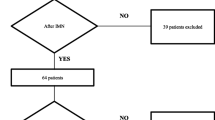Abstract
Intertrochanteric femur fracture nonunions are a rare complication that can be difficult to treat with limited evidence regarding treatment options. Revision fixation is typically reserved for well-aligned nonunions with sufficient femoral head bone stock. The most common implant used for revision fixation is a sliding hip screw implant. The use of a short cephalomedullary nail (CMN) for revision fixation has not been previously reported. This article presents a technique for reamed short CMN revision fixation of well-aligned nonunions with sufficient bone stock that is a simpler and potentially less morbid treatment option compared to open procedures with fixed-angle devices. For nonunions with poor femoral head bone stock and/or malaligned fractures, a fixed-angle implant, with or without a valgus osteotomy, may be necessary, while arthroplasty is reserved for nonunions with poor proximal femur bone stock that are not amenable to fixed-angle implant fixation.



Similar content being viewed by others
References
Parker MJ (2017) Sliding hip screw versus intramedullary nail for trochanteric hip fractures; a randomised trial of 1000 patients with presentation of results related to fracture stability. Injury 48:2762–2767. https://doi.org/10.1016/j.injury.2017.10.029
Arirachakaran A, Amphansap T, Thanindratarn P et al (2017) Comparative outcome of PFNA, Gamma nails, PCCP, Medoff plate, LISS and dynamic hip screws for fixation in elderly trochanteric fractures: a systematic review and network meta-analysis of randomized controlled trials. Eur J Orthop Surg Traumatol 27:937–952. https://doi.org/10.1007/s00590-017-1964-2
Hwang J, Hadeed M, Sapp T et al (2020) Varus displacement of intertrochanteric femur fractures on injury radiographs is associated with screw cutout. Eur J Orthop Surg Traumatol. https://doi.org/10.1007/s00590-020-02820-1
Haidukewych GJ, Berry DJ (2005) Salvage of failed treatment of hip fractures. J Am Acad Orthop Surg 13:101–109. https://doi.org/10.5435/00124635-200503000-00003
Haidukewych GJ, Berry DJ (2003) Salvage of Failed Internal Fixation of Intertrochanteric Hip Fractures. Clin Orthop Relat Res 412:184–188. https://doi.org/10.1097/01.blo.0000071753.41516.27
Xue D, Yu J, Zheng Q et al (2017) The treatment strategies of intertrochanteric fractures nonunion: An experience of 23 nonunion patients. Injury 48:708–714. https://doi.org/10.1016/j.injury.2017.01.042
Dhammi IK, Jain AK, Singh AP et al (2011) Primary nonunion of intertrochanteric fractures of femur: An analysis of results of valgization and bone grafting. Indian J Orthop 45:514–519. https://doi.org/10.4103/0019-5413.87122
Said GZ, Farouk O, El-Sayed A, Said HG (2006) Salvage of failed dynamic hip screw fixation of intertrochanteric fractures. Injury 37:194–202. https://doi.org/10.1016/j.injury.2005.09.011
Mariani EM, Rand JA (1987) Nonunion of intertrochanteric fractures of the femur following open reduction and internal fixation. Results of second attempts to gain union. Clin Orthop Relat Res 218:81–89
Min BW, Lee KJ, Oh JK et al (2020) Salvage treatment of failed internal fixation of intertrochanteric fractures: what factors determine the failure of treatment? Injury 51:367–371. https://doi.org/10.1016/j.injury.2019.12.004
Brinker M, O’Connor D, Monla Y, Earthman T (2007) Metabolic and endocrine abnormalities in patients with nonunions. J Orthop Trauma 21:557–570. https://doi.org/10.1097/BOT.0B013E31814D4DC6
Govaert GAM, Kuehl R, Atkins BL et al (2020) Diagnosing fracture-related infection: current concepts and recommendations. J Orthop Trauma 34:8–17. https://doi.org/10.1097/BOT.0000000000001614
Metsemakers WJ, Fragomen AT, Moriarty TF et al (2020) Evidence-based recommendations for local antimicrobial strategies and dead space management in fracture-related infection. J Orthop Trauma 34:18–29. https://doi.org/10.1097/BOT.0000000000001615
Robertson DS, Jenkins T, Murtha YM et al (2015) Effectiveness of vitamin D therapy in orthopaedic trauma patients. J Orthop Trauma 29:e451–e453. https://doi.org/10.1097/BOT.0000000000000366
Simpson AHRW, Wood MK, Athanasou NA (2002) Histological assessment of the presence or absence of infection in fracture non-union. Injury 33:151–155. https://doi.org/10.1016/S0020-1383(01)00078-X
Author information
Authors and Affiliations
Corresponding author
Ethics declarations
Conflict of interest
This research did not receive any specific grant from funding agencies in the public, commercial, or not-for-profit sectors. The authors have no specific disclosures related to this study.
Ethical approval
All procedures performed in studies involving human participants were in accordance with the ethical standards of the institutional and/or national research committee and with the 1964 Helsinki declaration and its later amendments or comparable ethical standards.
Informed consent
The institutional review board approved this study. Due to the retrospective nature of this work, informed consent was waived.
Additional information
Publisher's Note
Springer Nature remains neutral with regard to jurisdictional claims in published maps and institutional affiliations.
Rights and permissions
About this article
Cite this article
M. Mares, ., Hadeed, M.M. & Parry, J.A. Treatment of intertrochanteric nonunion after sliding hip screw fixation with a short cephalomedullary nail. Eur J Orthop Surg Traumatol 32, 1415–1421 (2022). https://doi.org/10.1007/s00590-021-03108-8
Received:
Accepted:
Published:
Issue Date:
DOI: https://doi.org/10.1007/s00590-021-03108-8




